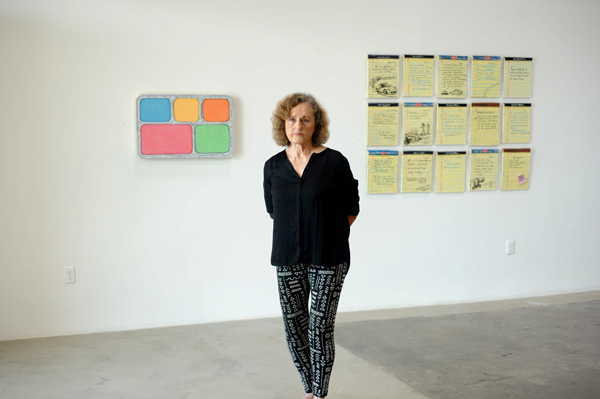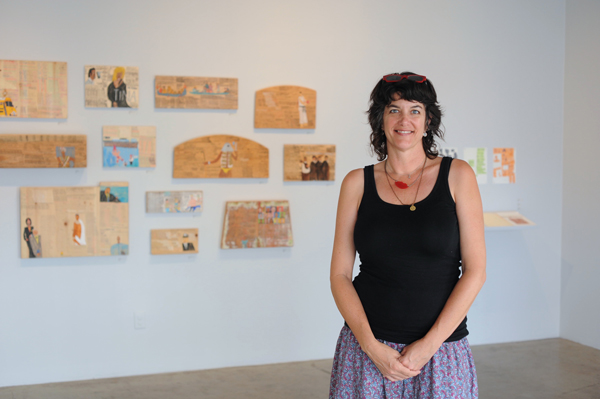The downtown Los Angeles arts district has been evolving, somewhat in tandem with adjacent downtown districts, since at least the 1980s. There was a stabilizing shift at the turn of the century when SCI-Arc took over the old Santa Fe rail depot east of Alameda and began renovating it into studio, classroom and related facilities. A natural anchor and boundary for the northwest end of the neighborhood, SCI-Arc brought a new focus and energy that radiated into Chinatown and neighborhoods to its northeast flank. Suddenly there were special exhibitions, performances, workshops, and parties—creativity seemed to blossom.
Within only a few years, the up-market tempo of Chinatown shifted to Culver City even as SCI-Arc stayed and flourished. But Chinatown didn’t exactly disappear. Another decade brought yet another shift—this time back to the downtown arts district. SCI-Arc, as it turned out, had lit a slow-burning fuse. What even the most dedicated art world nightfly might have been missing, though, between the inauguration of Night Gallery’s 16th Street space in 2013 and the throb of construction up and down the entire Santa Fe corridor, was the dramatic repurposing and transformation of the northwestern flank of the arts district west of SCI-Arc’s seeming companion, upscale residential development One Santa Fe. Anyone venturing into the neighborhood from east or west last March for the opening of Hauser, Wirth & Schimmel’s (HW&S) 3rd Street megaplex would have been freshly aware of the radically transformed urban space nearby.

Santa Fe One district, across from SCI-Arc
Over the months since its debut, HW&S’ focus and programming has borne some resemblance—albeit on a grander scale—to 356 Mission, the studio/art gallery/community arts center that is Laura Owens’ brainchild. Although HW&S’ natural first constituency would seem to be the community of Los Angeles artists from which it has drawn so richly in the recent past, its commitment to museum-grade historical shows is clearly intended to open it up to a larger, traditional museum-going audience of the curious and culturally aware. It remains to be seen how many of this larger audience the gallery can convert into collectors—or whether such neophyte collectors might be ready to accommodate (even physically) the gallery’s artists (and vice versa).
Further down Santa Fe, a mood of elation prevailed at Night Gallery, where a magnificent double show—a solo debut by a New York-based Chinese artist and a triple show curated by Shi Zheng, including photographer and video artist Cheng Ran—was warmly received. If success were measured by artists’ consistent interest and engagement, Night Gallery would set the standard HW&S might embrace for its own. Night Gallery openings are routinely mobbed and frequently a spot where a gallery-hopping evening might begin or end.

François Ghebaly in his gallery office, photo by Eric Minh Swenson.
At Ghebaly Gallery, just across the parking lot, the mood was considerably cooler, notwithstanding two spectacular solo shows by Neil Beloufa and Patrick Jackson. Ghebaly is successful by almost any measure—Beloufa’s show looked to be museum-ready; but neither the gallery’s staff, nor its principal, François Ghebaly, take anything for granted. Ghebaly seemed tentative and on-edge for the few moments he was able to sit down for a few questions. During the week or so that I pursued him for a brief interview, he was pressed between a schedule tight with back-to-back meetings with collectors and the always-fraught logistics of navigating LA. Whether or not Ghebaly has anything that might be called a “typical” collector, the best work here tends to require a level of personal interaction and physical engagement for which a prospective collector might not be immediately available. Setting aside questions of direct or immediate collector engagement, Ghebaly agreed that the Internet had changed everything over the last decade, if not earlier.

Rosamund Felsen in her gallery with her last show, photo by Tyler Hubby.
Only a few blocks away, Rosamund Felsen was familiar with doing business online; but had some issues about collectors’ engagement with the work, and especially their engagement with the work of her own artists. “Collectors aren’t coming to the gallery anymore.” Felsen was direct. There was no reason not to be; she had just opened her final show and would be closing the gallery by the end of the season. (Felsen will continue doing business as a private dealer.) It signaled a historic moment in the context of the LA art world since the late ’70s and ’80s. “Collectors have changed.” The implication was that the change was more profound than technology or economic trends could explain. “The change is in the visual experience—they don’t know what the exhibition experience is about.”
There is a learning curve between the direct visual or exhibition experience and serious collecting. Retracing some of her own early experiences as a young gallerist on La Cienega Boulevard, Felsen described a process of initiation between museum-related education and first-time gallery acquisitions that occurs far less often in the 21st century. “LACMA curators would bring in groups of collectors—museum support groups—and get them to look at the art; they’d take them into the studios to see how it was made.”
The educational experience—whether museum-related or otherwise—was itself beginning to seem depleted to Felsen. “It seems more of an academic experience—more intellectual or conceptual; there isn’t the same emphasis on technique.” Felsen wasn’t referring to the kind of conceptual or postconceptual work that was as well-represented in her gallery as anywhere else in Los Angeles, but the kind of first-hand contact with the creative process that seems lost on many prospective “collectors.”
“They’ll come in and ask, ‘where is this going?’”—referring strictly to market valuation. “I don’t market,” Felsen says bluntly.
Across town at the Hammer Museum’s Made In L.A. biennial, co-curator Hamza Walker did not see the Internet or globalization having a strong impact on the art world, much less the way we experience art. “Relative to the greater upheaval of modernism, it’s a red herring.” As far as globalization’s economic aspects were concerned, wasn’t this simply another term for “late capitalism”?
This didn’t exactly ‘scale’ with me in any sense. Hadn’t the Internet brought some of those outliers and outsiders closer to the mainstream art “conversation”? “The conversation is still the same.”
“You want to be noticed,” says one of the most charming and unassuming gallerists in Los Angeles. There’s no superfluous tszuj at Richard Telles Fine Art. You walk past the front desk through a narrow hall into a gallery, a long, deep, very high-ceilinged pristine room that will comfortably accommodate a modest single-artist show. The business plan was simple: “I would do the kinds of shows that I want with smart, intelligent artists.” Bucking trends, Telles has expanded his footprint on Beverly Boulevard only modestly since the gallery’s 1993 inauguration. “You’re fighting for survival in a very average market.” But Telles is clearsighted about his priorities. “The connection with the artist is important.”
“The art world is changing,” Telles acknowledged. “There’s some big growth at the edges; but the core group of collectors hasn’t grown. People are buying where there’s ‘heat.’ People are spending more; but you have collectors who have never bought art seriously.”
Telles has felt the “heat” at art fairs, but believes it’s getting harder to escape with even a modest profit. “You’re there to prop up the big galleries who only need to sell one or two pieces to make back their investment.” Inevitably, too, the Internet has beaten its cybertronic path to his door; but the queries are at least as informed as they are random. “They’ll have some sense of what the work looks like.”
Richard Heller has also stayed put at his Bergamot Station gallery in Santa Monica. Like Telles’, his artist roster reflects a distinctive taste, sensibility and judgment. Heller’s gallery was where I first saw Marcel Dzama and other “Royal Art Lodge” artists out of Winnipeg; one can usually count on a slightly surreal edge to the work exhibited there. “I think the focus started with Raymond Pettibon in the late 1980s. When I had a gallery on La Brea with Bennett Roberts, we did a couple great exhibitions of his work. This in turn opened my mind to artists like Marcel Dzama… and the rest of the Royals. I’m so proud to see Dzama and Pettibon collaborating on work [for David Zwirner]; it’s one of the few vindications of my career.” Heller is modest. He has a fairly deep collector base by his own account and is fortunate enough to do as much as 85% of his business out of the LA market. Despite the geographic ‘heat’ of the Highland/La Brea and downtown arts neighborhoods, “we still likely get more visitors on an average day here in Santa Monica than anywhere else in the city.”
Heller’s overall approach tends to resist “the herd.” You can’t “buy into the madness,” he says. “The most important thing is to look at art, listen to people, but more importantly make your own decisions.”

Paige Wery of The Good Luck Gallery, photo by Tyler Hubby.
Paige Wery, the former publisher of this magazine, and now the proprietor of a gallery dedicated to outsider art, The Good Luck Gallery, has fixed on an entirely different ‘herd’ to run with. “This is coming from a place so deep… People are tired of looking at art that looks so similar. These are artists with very individual voices. They’re nonverbal; yet this pours out of them. This is the way they communicate. It’s innate—the language is all in the art.”
Since opening her gallery two years ago, Wery already has at least 300 collectors, with about half the business done online and half in person. An email thread often leads to a confirmed sale that ultimately brings the collector into the gallery to make another purchase. But it’s never easy. “The more popular your artists get, the more work you have to do.” Given the wave of populism in globalization’s wake, I asked Wery if she thought there was a political dimension to it. “Political? People are sick of conceptual art.”
But even at The Good Luck there were parallels to the mainstream art world: a commitment to the artists themselves. “My focus is on my community. I’m building an awareness of people with disabilities… It’s a certain way of being politically active.”
Wery’s comment about her “community”—really a diaspora of the disabled and disconnected, empowered only by their art; and complemented by collectors similarly dispersed, all drawn to a product of imagination and creativity beyond categorization—brought me back to the larger Los Angeles arts “community.” Much as artists and LA’s creative gypsies have defined what little human sense of place there is here, that sense has always been strongly influenced and impacted by financial and industrial forces half a continent and now half a world away. Globalization and technology have brought both increased diversity and increased standardization and uniformity, which only magnify a sense of artificiality felt so acutely here—and not just in the HW&S neighborhood. Artists (and technologists) are usually well equipped to respond to these cultural discontinuities; but there is alienation there, too—figurative and literal displacement. The conversation is no longer strictly local; and neither is the art, its connection to that place we call Los Angeles entirely contingent and unstable. In the meantime, connections to audiences (and collectors) may be similarly strained as the ground shifts (literally) beneath our feet.


